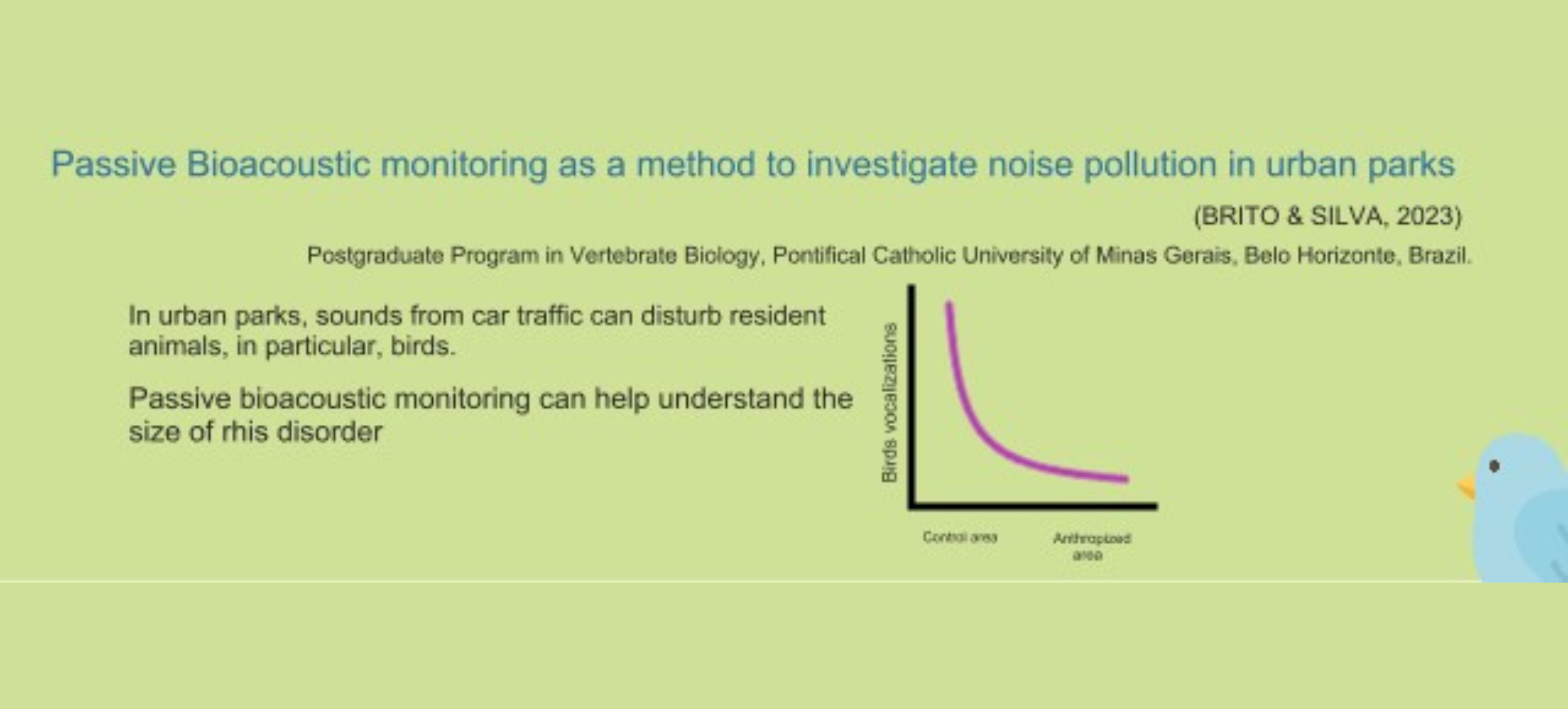Passive bioacoustic monitoring as a method to investigate noise pollution in urban parks
DOI:
https://doi.org/10.14295/bjs.v3i1.440Keywords:
biophony, conservation, public policies, urbanism, one-healthAbstract
The acoustic landscape of a place is formed by biophony, anthropophony and geophony. Biophony comprises the sounds produced by living beings, mainly animals during their communications; geophony consists of the sounds of the geophysical environment, like a river, the rain and waterfalls. In this case study, we evaluated the effectiveness of passive bioacoustic monitoring in detecting anthropogenic pollution in an urban park in Belo Horizonte, Brazil. We used the Song Meter recorder model SM2+ from the Wildlife Acoustics, the recorders were configured to receive sounds of up to 20 Hz. Each recorder was fixed in trees 1.5 m above the ground and 2 microphones were used in each of them. The collected data were submitted to the Generalized Linear Model Test (GLMM), which resulted in a strong influence of anthropic noises on the birds' vocalization. Our results demonstrate the effectiveness of the method and point to the need for the development of public policies to mitigate the effects of noise pollution in urban parks.
References
Andrade, B. M. T. (2021). Paisagem acústica em um fragmento de mata atlântica com diferentes anos de reflorestamento. Dissertação de Mestrado em Biologia Animal pela Universidade Federal de Pernambuco, Recife, Pernambuco, Brasil, 71 f. https://repositorio.ufpe.br/handle/123456789/43615
Caorsi, V. Z. (2018). Efeito do ruído antropogênico no comportamento animal. Tese de Doutorado em Biologia Animal pela Universidade Federal do Rio Grande do Sul, Porto Alegre, Rio Grande do Sul, Brasil, 157 f. http://hdl.handle.net/10183/193632
Dias, A. F. S. (2013). Competição por espaço acústico: adaptações de cantos de aves em uma zona de alta biodiversidade do Brasil Central. Tese de Doutorado em Ecologia pela Universidade de Brasília, Brasília, Brasil, 87 f. https://repositorio.unb.br/handle/10482/14853
Francis, C. D., & Barber, J. R. (2013). A framework for understanding noise impacts on wildlife: an urgent conservation priority. Frontiers in Ecology and the Environment, 11(6), 305-313. https://doi.org/10.1890/120183 DOI: https://doi.org/10.1890/120183
Gomes, B. Z., Martins, F. R., & Tamashiro, J. Y. (2004). Estrutura do cerradão e da transição entre cerradão e floresta a paludícola num fragmento da International Paper do Brasil Ltda., em Brotas, SP. Brazilian Journal of Botany, 27(2), 249-262. https://doi.org/10.1590/S0100-84042004000200005 DOI: https://doi.org/10.1590/S0100-84042004000200005
Pieretti, N., & Farina, A. (2013). Application of a recently introduced index for acoustic complexity to an avian soundscape with traffic noise. The Journal of the Acoustical Society of America, 134(1), 891-900. https://doi.org/10.1121/1.4807812 DOI: https://doi.org/10.1121/1.4807812
Pugliano, S. E. (2021). Uso de gravadores autônomos para detecção de aves noturnas em paisagens fragmentadas de Mata Atlântica. Trabalho de Conclusão de Curso Bacharelado em Ciências Biológicas pela Universidade Estadual Paulista, Rio Claro, São Paulo, Brasil, 37 f. https://repositorio.unesp.br/handle/11449/214237
Rheindt, F. E. (2003). The impact of roads on birds: does song frequency play a role in determining susceptibility to noise pollution? Journal Für Ornithologie, 144(3), 295-306. https://doi.org/10.1046/j.1439-0361.2003.03004.x DOI: https://doi.org/10.1046/j.1439-0361.2003.03004.x

Downloads
Published
How to Cite
Issue
Section
License
Copyright (c) 2024 Luan de Jesus Matos de Brito, Paula Vitória Silva

This work is licensed under a Creative Commons Attribution 4.0 International License.
Authors who publish with this journal agree to the following terms:
1) Authors retain copyright and grant the journal right of first publication with the work simultaneously licensed under a Creative Commons Attribution License that allows others to share the work with an acknowledgement of the work's authorship and initial publication in this journal.
2) Authors are able to enter into separate, additional contractual arrangements for the non-exclusive distribution of the journal's published version of the work (e.g., post it to an institutional repository or publish it in a book), with an acknowledgement of its initial publication in this journal.
3) Authors are permitted and encouraged to post their work online (e.g., in institutional repositories or on their website) prior to and during the submission process, as it can lead to productive exchanges, as well as earlier and greater citation of published work.




